Methods of manufacturing a multi-device package
Kuan , et al.
U.S. patent number 10,373,922 [Application Number 14/731,382] was granted by the patent office on 2019-08-06 for methods of manufacturing a multi-device package. This patent grant is currently assigned to Micron Technology, Inc.. The grantee listed for this patent is Micron Technology, Inc.. Invention is credited to Shih-Fan Kuan, Yi-Jen Lo.
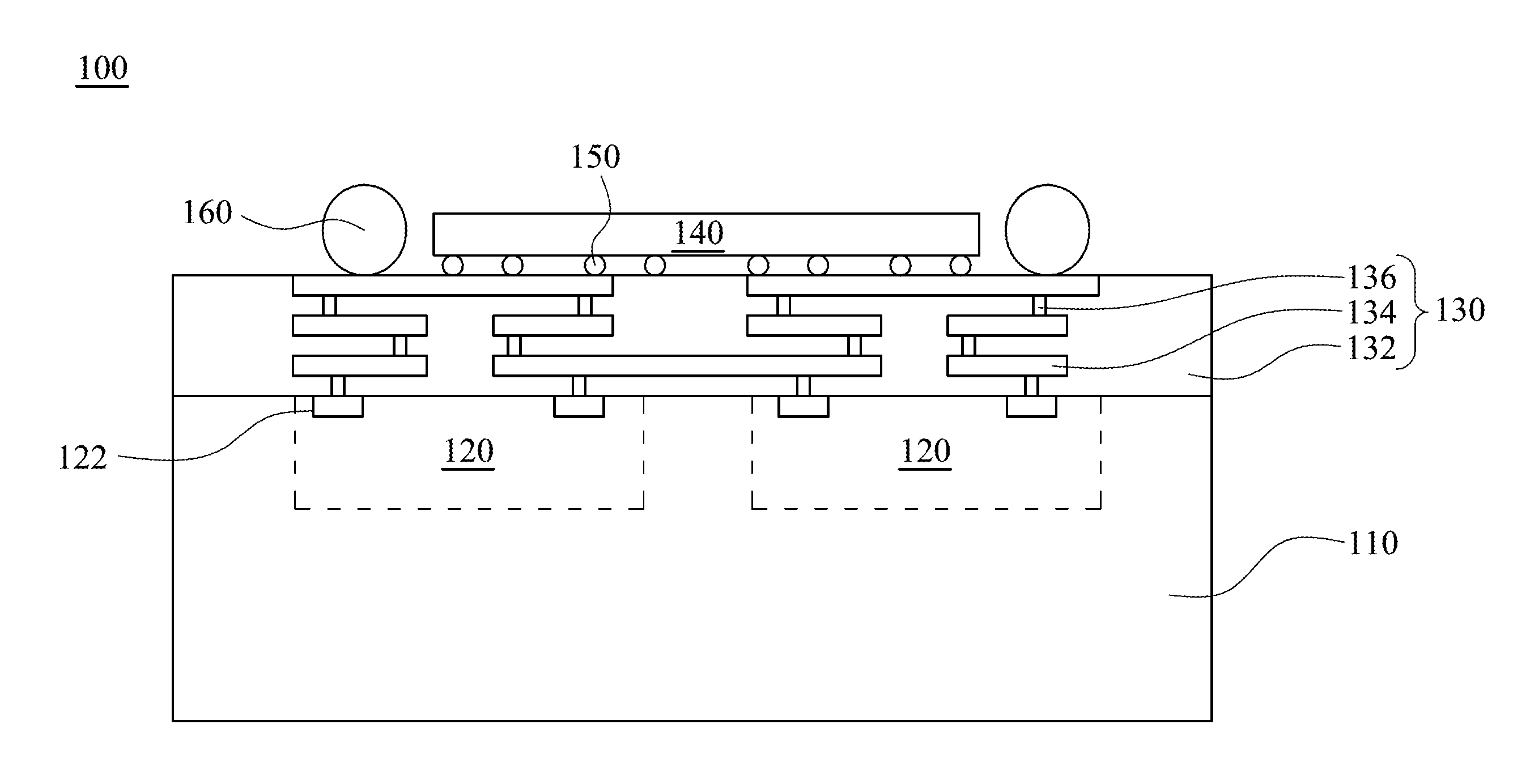
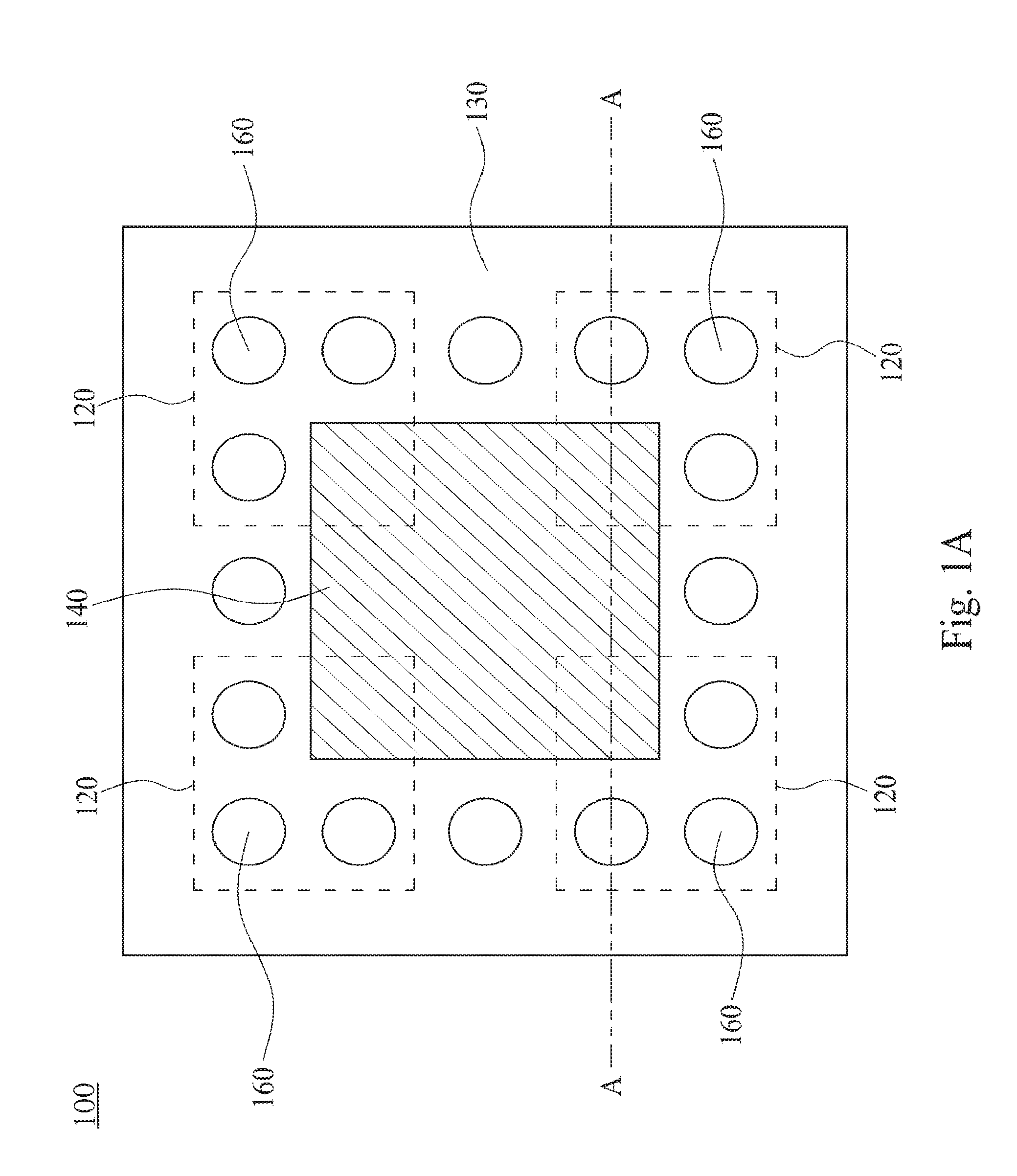
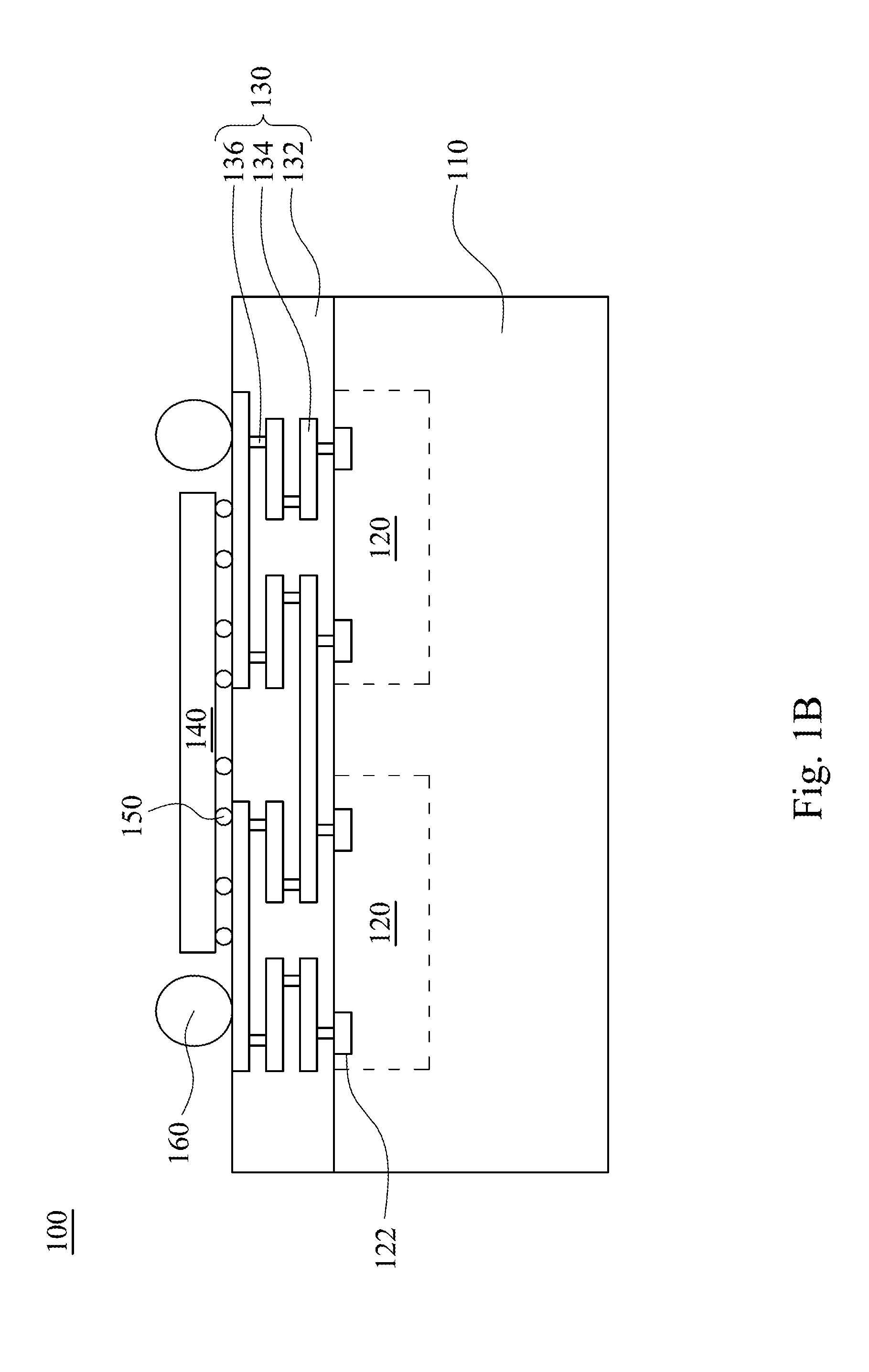
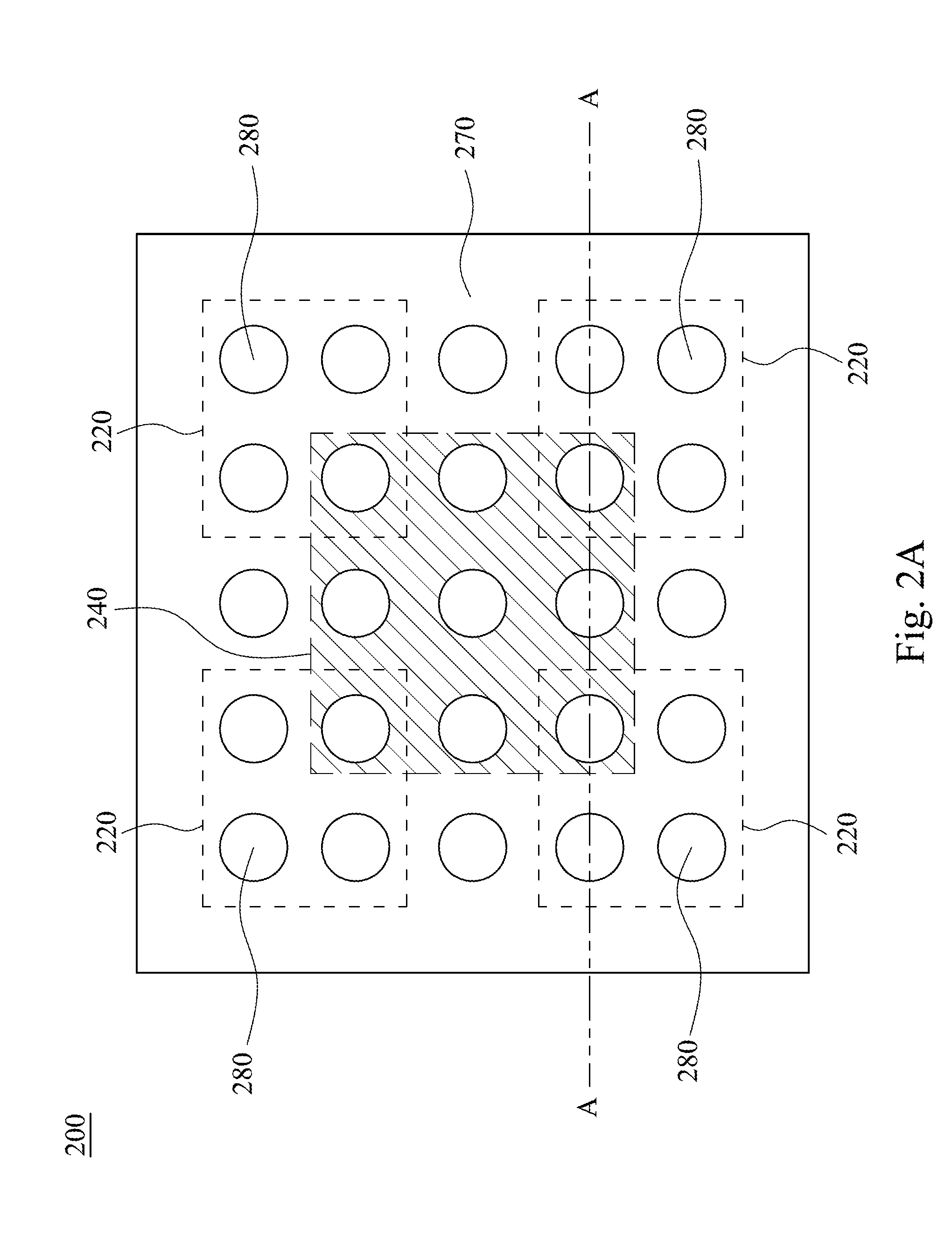
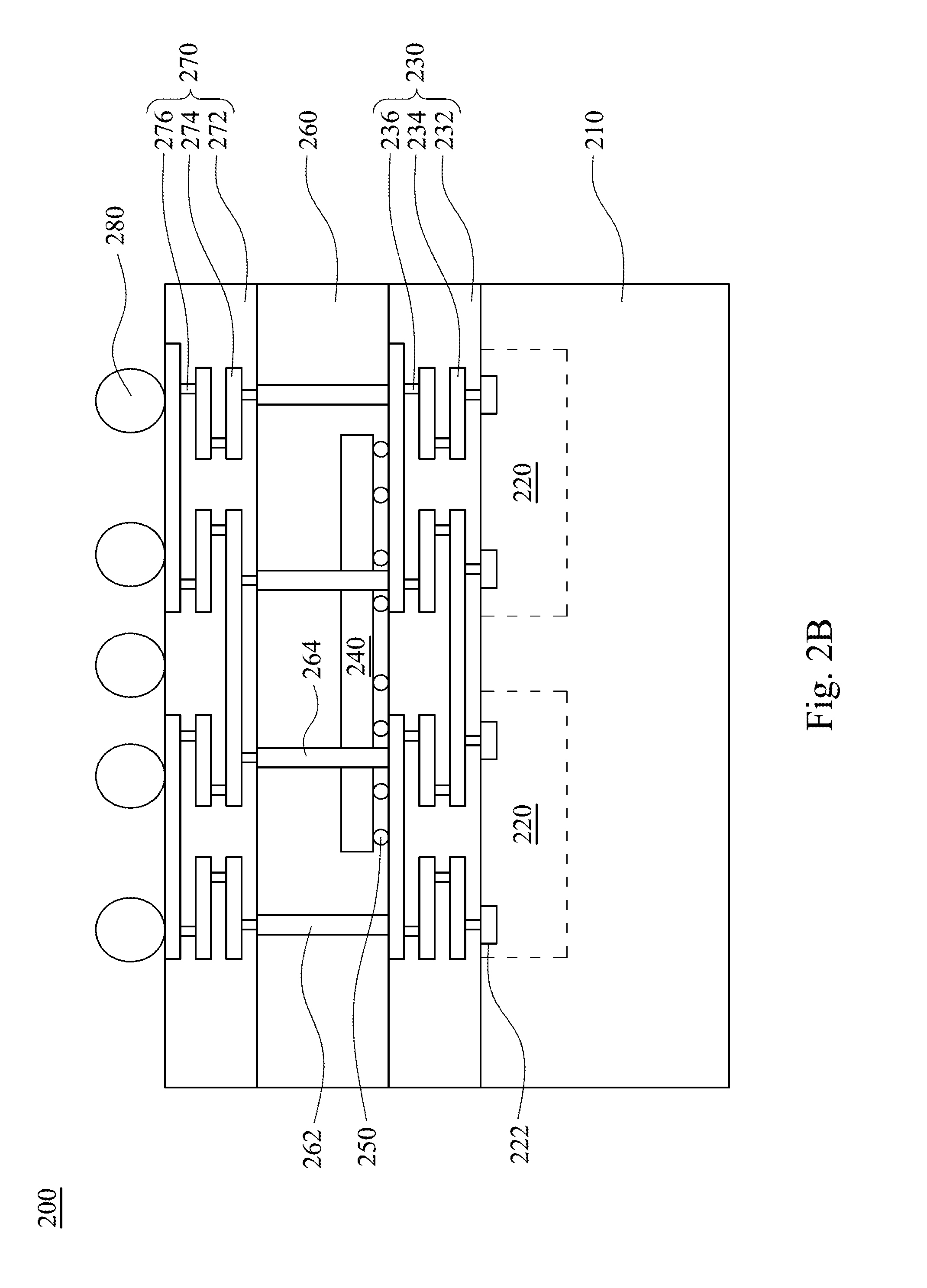
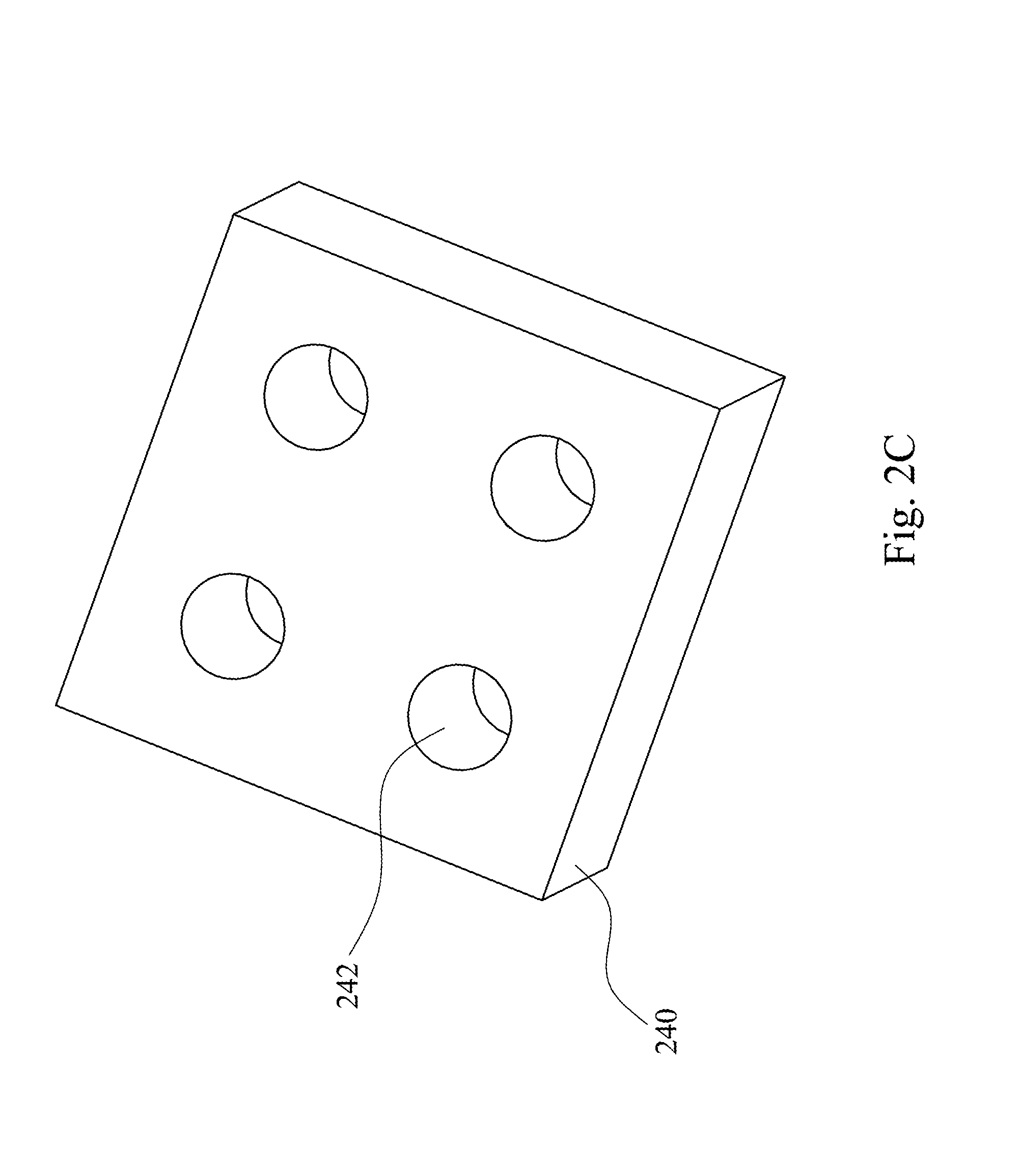
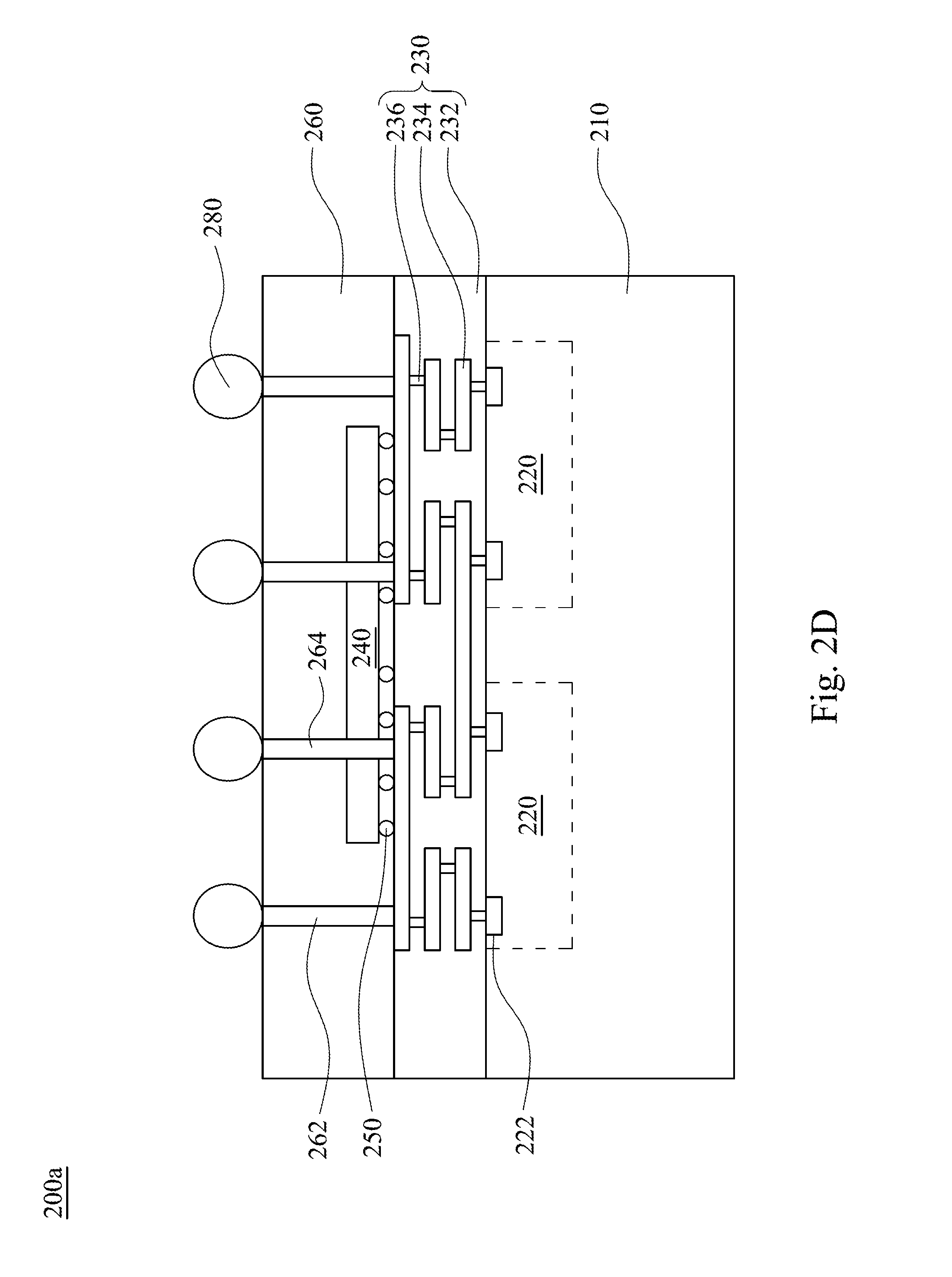
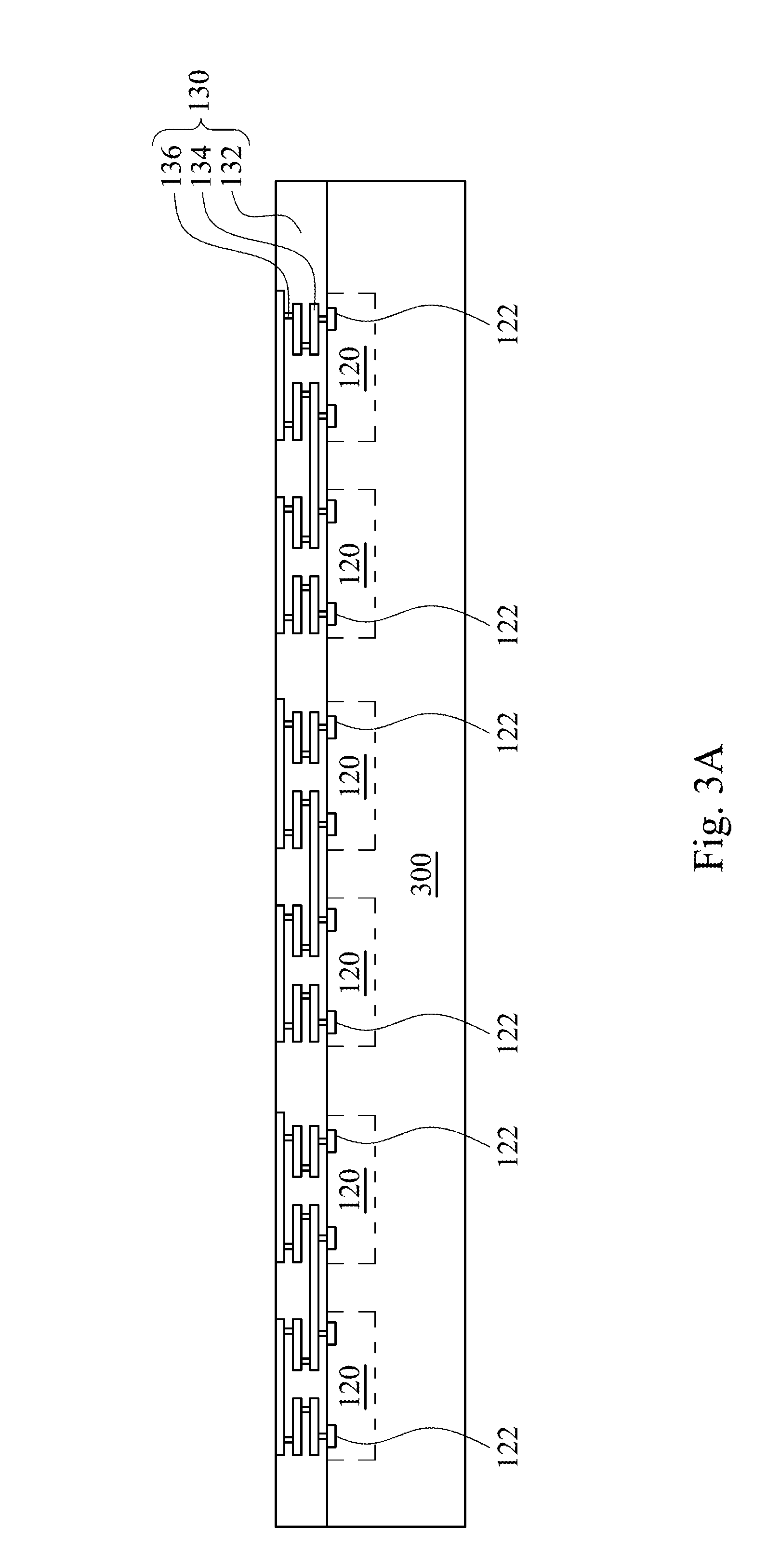
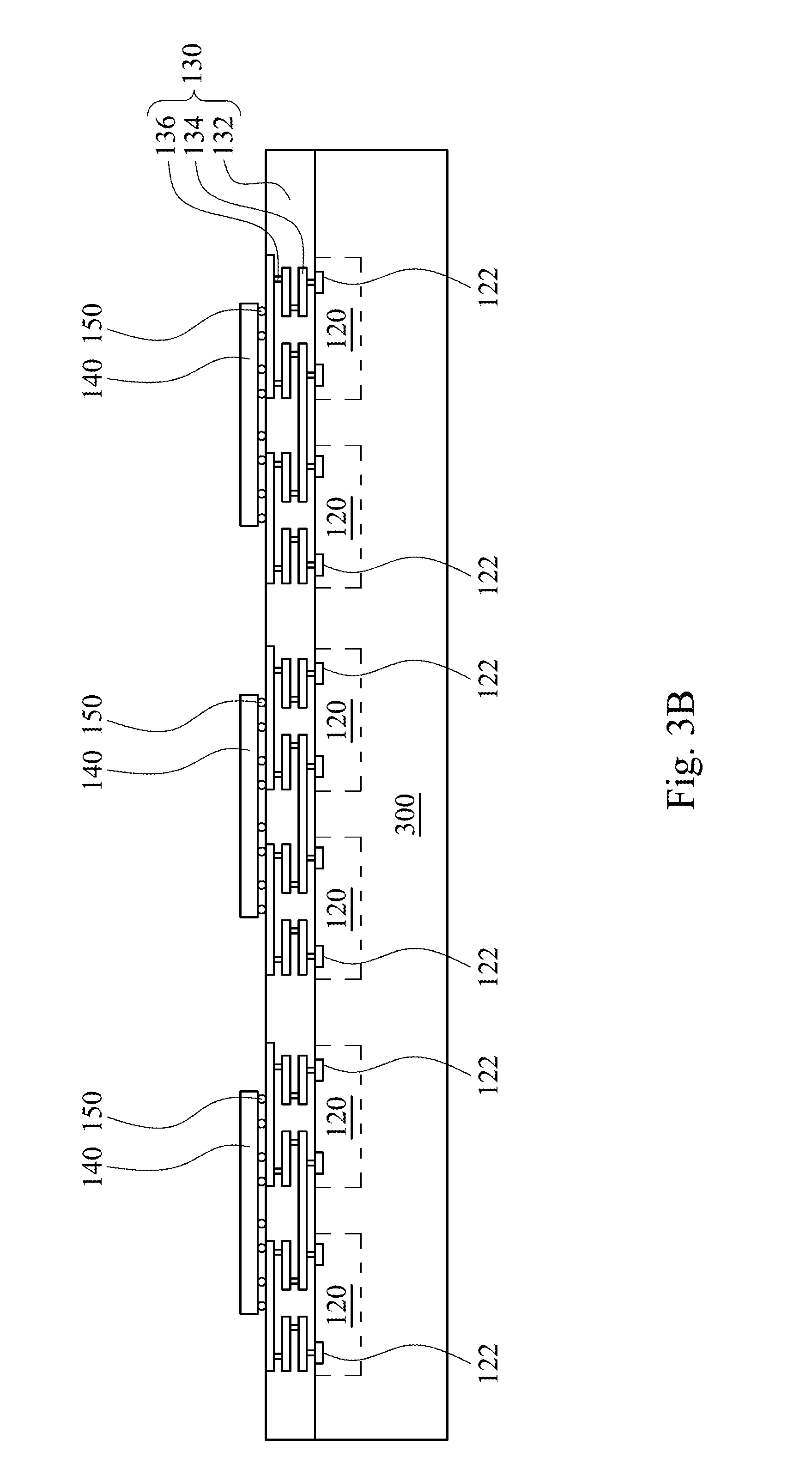
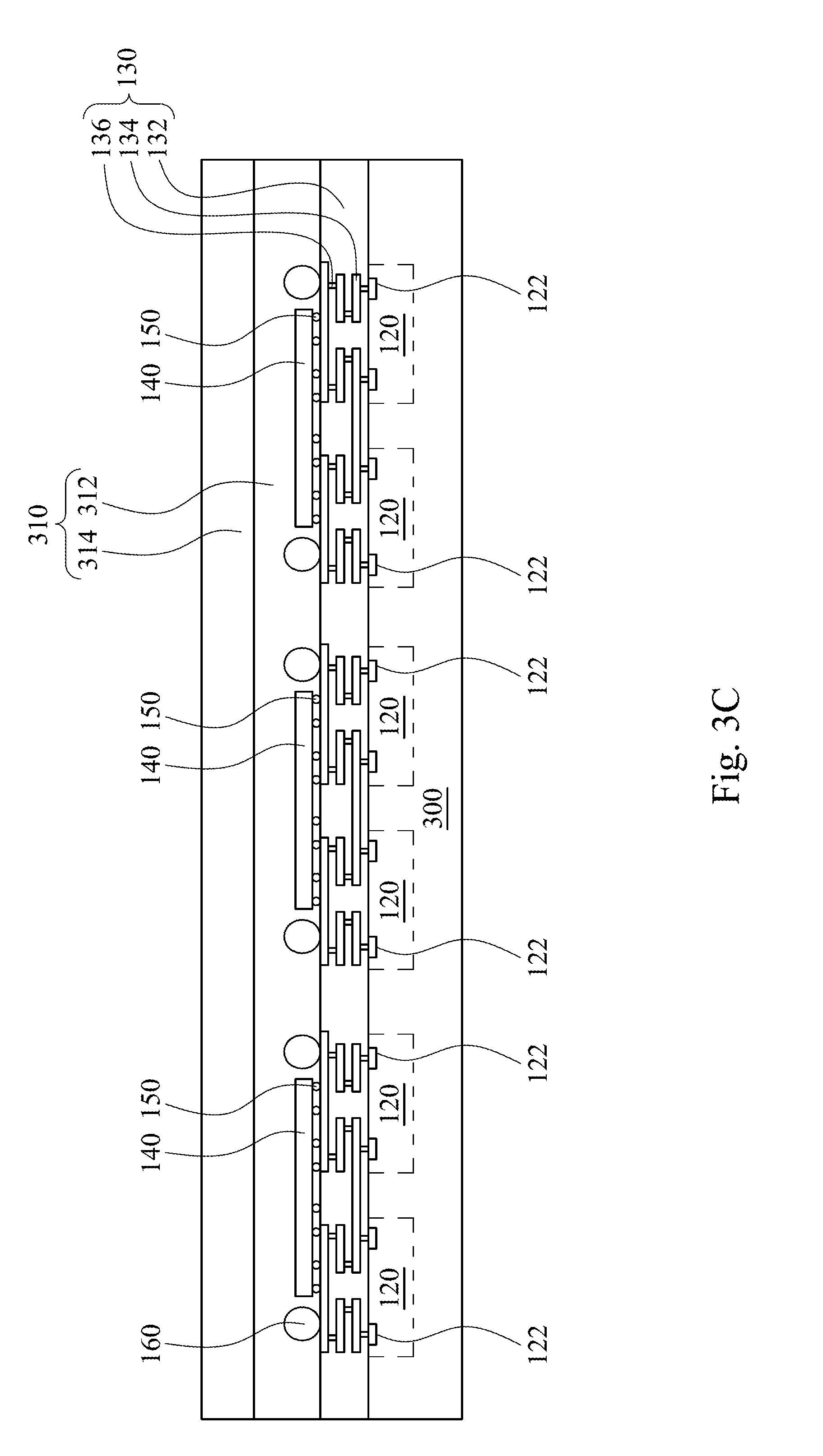
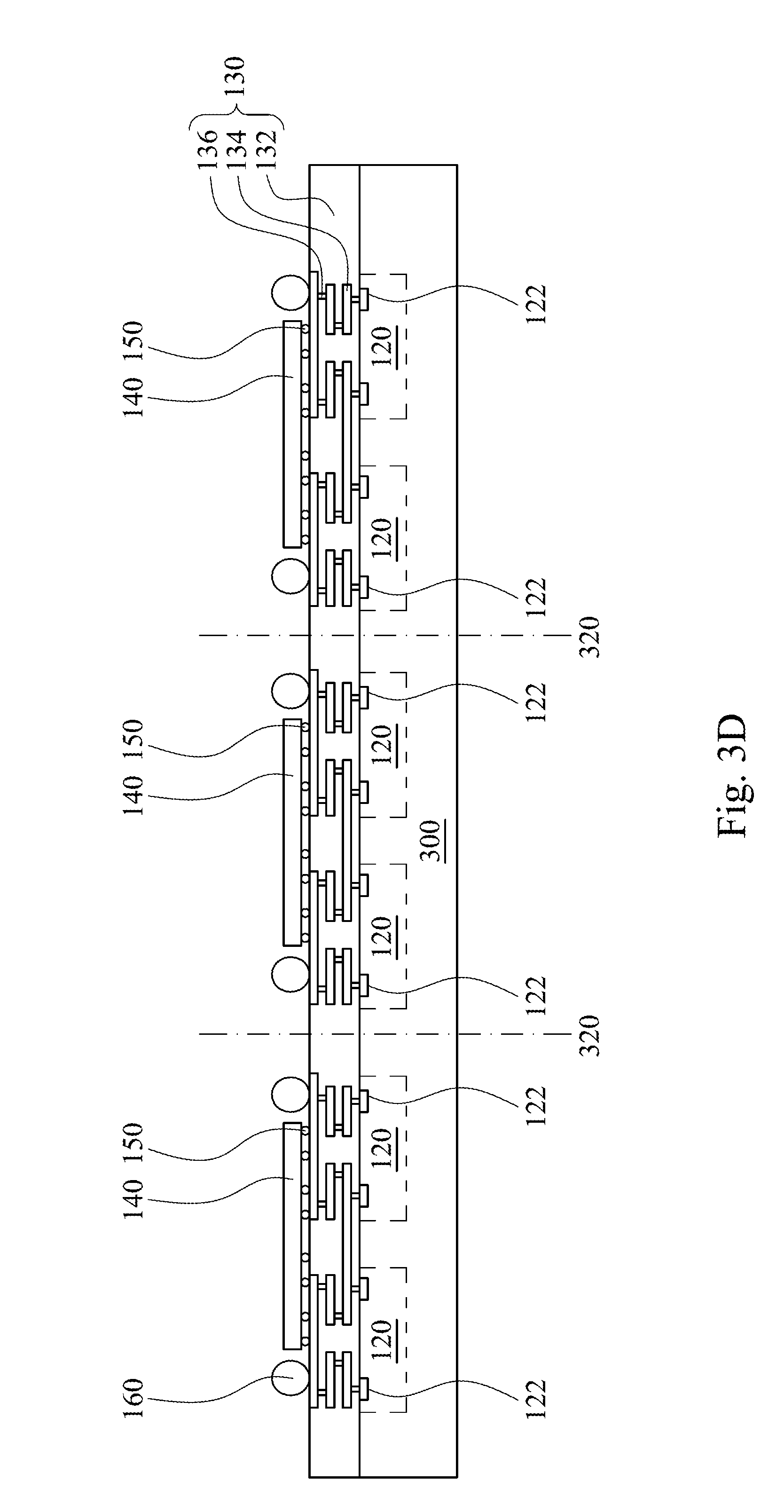
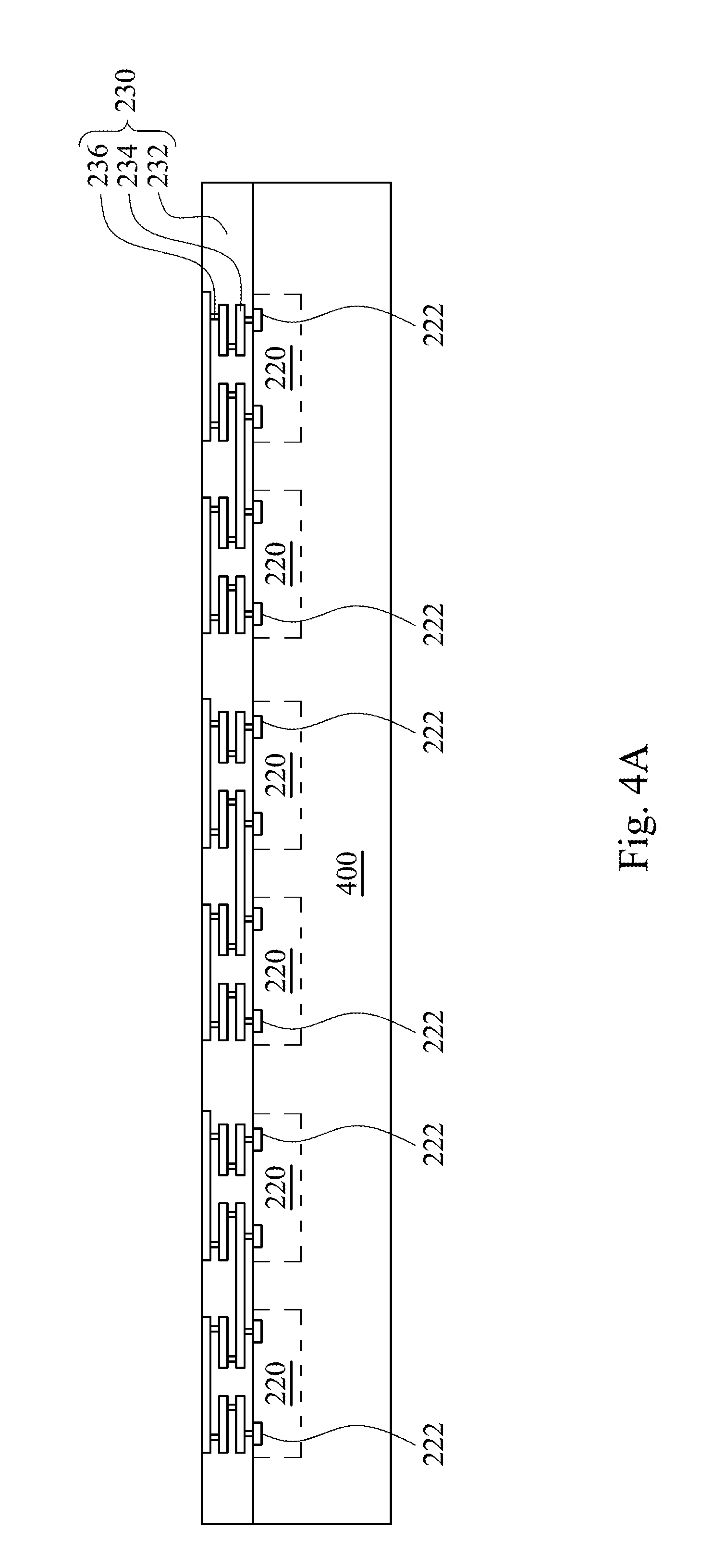
View All Diagrams
| United States Patent | 10,373,922 |
| Kuan , et al. | August 6, 2019 |
| **Please see images for: ( Certificate of Correction ) ** |
Methods of manufacturing a multi-device package
Abstract
A multi-device package includes a substrate, at least two device regions, a first redistribution layer, an external chip and a plurality of first connectors. The two device regions are formed from the substrate, and the first redistribution layer is disposed on the substrate and electrically connected to the two device regions. The external chip is disposed on the first redistribution layer, and the first connectors are interposed between the first redistribution layer and the external chip to interconnect the two.
| Inventors: | Kuan; Shih-Fan (Taoyuan, TW), Lo; Yi-Jen (New Taipei, TW) | ||||||||||
|---|---|---|---|---|---|---|---|---|---|---|---|
| Applicant: |
|
||||||||||
| Assignee: | Micron Technology, Inc. (Boise,
ID) |
||||||||||
| Family ID: | 57452410 | ||||||||||
| Appl. No.: | 14/731,382 | ||||||||||
| Filed: | June 4, 2015 |
Prior Publication Data
| Document Identifier | Publication Date | |
|---|---|---|
| US 20160358870 A1 | Dec 8, 2016 | |
| Current U.S. Class: | 1/1 |
| Current CPC Class: | H01L 23/5389 (20130101); H01L 24/92 (20130101); H01L 21/76877 (20130101); H01L 21/4846 (20130101); H01L 24/09 (20130101); H01L 21/82 (20130101); H01L 24/97 (20130101); H01L 21/6836 (20130101); H01L 24/02 (20130101); H01L 24/94 (20130101); H01L 24/17 (20130101); H01L 23/5384 (20130101); H01L 23/3114 (20130101); H01L 2224/73209 (20130101); H01L 23/49816 (20130101); H01L 2224/92122 (20130101); H01L 2224/131 (20130101); H01L 2224/11 (20130101); H01L 2224/13024 (20130101); H01L 2224/04105 (20130101); H01L 21/561 (20130101); H01L 2224/1703 (20130101); H01L 2224/92 (20130101); H01L 2221/6834 (20130101); H01L 2224/023 (20130101); H01L 2224/0231 (20130101); H01L 2224/12105 (20130101); H01L 2224/11849 (20130101); H01L 2224/13111 (20130101); H01L 2224/97 (20130101); H01L 24/11 (20130101); H01L 2221/68327 (20130101); H01L 2224/16145 (20130101); H01L 24/13 (20130101); H01L 2924/014 (20130101); H01L 24/16 (20130101); H01L 2224/0237 (20130101); H01L 2224/81 (20130101); H01L 2224/9202 (20130101); H01L 23/525 (20130101); H01L 2224/94 (20130101); H01L 2224/97 (20130101); H01L 2224/81 (20130101); H01L 2224/94 (20130101); H01L 2224/81 (20130101); H01L 2224/13111 (20130101); H01L 2924/014 (20130101); H01L 2224/9202 (20130101); H01L 2224/11 (20130101); H01L 2224/94 (20130101); H01L 2224/11 (20130101); H01L 2224/92122 (20130101); H01L 2224/11 (20130101); H01L 2224/94 (20130101); H01L 2224/0231 (20130101); H01L 2224/11849 (20130101); H01L 2924/00012 (20130101); H01L 2224/92 (20130101); H01L 2224/0231 (20130101); H01L 2224/81 (20130101); H01L 21/56 (20130101); H01L 2224/11 (20130101); H01L 2224/9202 (20130101); H01L 2224/11 (20130101); H01L 2221/68304 (20130101); H01L 21/304 (20130101); H01L 2224/92 (20130101); H01L 2224/0231 (20130101); H01L 2224/81 (20130101); H01L 21/56 (20130101); H01L 2224/11 (20130101); H01L 2224/9202 (20130101); H01L 2224/03 (20130101); H01L 2221/68304 (20130101); H01L 21/304 (20130101); H01L 2224/131 (20130101); H01L 2924/014 (20130101) |
| Current International Class: | H01L 23/00 (20060101); H01L 21/82 (20060101); H01L 23/538 (20060101); H01L 21/48 (20060101); H01L 23/31 (20060101); H01L 21/768 (20060101); H01L 23/525 (20060101); H01L 23/498 (20060101) |
References Cited [Referenced By]
U.S. Patent Documents
| 6222212 | April 2001 | Lee et al. |
| 8304896 | November 2012 | England |
| 2004/0212030 | October 2004 | Asai |
| 2008/0316714 | December 2008 | Eichelberger et al. |
| 2009/0077796 | March 2009 | Sakamoto |
| 2011/0037169 | February 2011 | Pagaila |
| 2011/0057327 | March 2011 | Yoshida et al. |
| 2011/0084382 | April 2011 | Chen et al. |
| 2013/0056871 | March 2013 | Yu |
| 2013/0105991 | May 2013 | Gan |
| 2015/0108653 | April 2015 | Hooper |
| 2015/0162265 | June 2015 | Jo |
| 103000619 | Mar 2013 | CN | |||
| 103270588 | Aug 2013 | CN | |||
| 2008166824 | Jul 2008 | JP | |||
| 201114009 | Apr 2011 | TW | |||
| I482257 | Apr 2015 | TW | |||
Other References
|
Chinese Office Action and Search Report from Chinese Application No. 201510534702.2, dated Apr. 17, 2018, 16 pages with English translation. cited by applicant. |
Primary Examiner: Toledo; Fernando L
Attorney, Agent or Firm: TraskBritt
Claims
What is claimed is:
1. A method of manufacturing a multi-device package, the method comprising: forming at least two device regions from a wafer and within the wafer by using material of the wafer; forming a first redistribution layer on the wafer, the first redistribution layer being electrically connected to the at least two device regions to electrically integrate the at least two device regions; forming a plurality of first connectors on the first redistribution layer; mounting an external chip on the plurality of first connectors, the external chip being electrically connected to the first redistribution layer by the plurality of first connectors; forming a plurality of second connectors on the first redistribution layer, a diameter of a second connector of the plurality of second connectors being larger than a sum of a diameter of a first connector of the plurality of first connectors and a thickness of the external chip; forming a temporary adhesive layer covering the plurality of second connectors and the external chip; thinning the wafer; removing the temporary adhesive layer; and thereafter dicing the wafer along a scribe line to form the multi-device package.
2. The method of claim 1, wherein mounting the external chip comprises mounting the external chip having a first through hole.
3. The method of claim 2, further comprising: forming a molding layer covering the first redistribution layer and the external chip; removing a portion of the molding layer to form a second through hole and a third through hole, the second through hole exposing the first redistribution layer, the third through hole being through the first through hole to expose the first redistribution layer; and filling a conductive material in the first through hole, the second through hole, and the third through hole to form a first conductive contact and a second conductive contact.
4. The method of claim 3, further comprising: forming a second redistribution layer on the molding layer, the second redistribution layer being electrically connected to the first conductive contact and the second conductive contact; and forming a plurality of third connectors on the second redistribution layer.
5. The method of claim 4, further comprising: forming a temporary adhesive layer covering the plurality of third connectors and the second redistribution layer; thinning the wafer; and removing the temporary adhesive layer.
6. The method of claim 1, wherein forming the first redistribution layer on the wafer comprises: depositing a dielectric material covering the wafer; removing a portion of the dielectric material to form openings exposing the at least two device regions of the wafer; forming vias in the openings; forming a metal layer on the vias; and patterning the metal layer.
7. The method of claim 4, wherein forming the second redistribution layer on the molding layer comprises: forming a dielectric material covering the molding layer; removing a portion of the dielectric material to form openings exposing the first conductive contact and the second conductive contact; forming vias in the openings; forming a metal layer on the vias; and patterning the metal layer.
8. A method of manufacturing a multi-device package, the method comprising: forming at least two device regions from a wafer and within the wafer by using material of the wafer; forming a redistribution layer on the wafer, the redistribution layer being electrically connected to the at least two device regions to electrically integrate the at least two device regions; forming a plurality of connectors on the redistribution layer; mounting an external chip on the plurality of connectors, the external chip being electrically connected to the redistribution layer by the plurality of connectors; performing testing of individual devices comprising the at least two device regions; and thereafter dicing the wafer along a scribe line to form the multi-device package.
9. A method of manufacturing a multi-device package, the method comprising: forming at least two device regions from a wafer and within the wafer by using material of the wafer; forming a redistribution layer on the wafer, the redistribution layer being electrically connected to the at least two device regions to electrically integrate the at least two device regions, wherein forming the redistribution layer on the wafer comprises forming conductive pads recessed within the wafer, wherein the conductive pads form an uppermost metal layer of a metal interconnect structure of the first redistribution layer; forming a plurality of connectors on the redistribution layer; mounting an external chip on the plurality of connectors, the external chip being electrically connected to the redistribution layer by the plurality of connectors; and thereafter dicing the wafer along a scribe line to form the multi-device package.
Description
BACKGROUND
Along with the evolution in the manufacturing technology of semiconductor devices, the functional density of the semiconductor devices has increased with the decrease of device sizes to achieve higher integration density of the semiconductor devices. As a result, demands to packaging technology are becoming severe under conditions of decreases in size and increases in density of the semiconductor devices. In recent years, the demands to the smaller electronic devices have increased, and innovative packaging technology is required.
Generally, several devices are fabricated in a wafer, and a dicing process is performed to separate these devices into individual chips. These chips are placed on a carrier substrate, and a packaging process is performed to integrate multiple chips into one package. However, these chips suffer vibration when being placed on the carrier substrate, and problems of disconnection and fracture may easily occur to the chips, which decreases the yield of the package. In addition, extra costs for the carrier substrate further decrease efficiency of the packaging process. Therefore, a novel packaging structure and a manufacturing process thereof are necessary to solve problems mentioned above.
BRIEF SUMMARY
The present disclosure provides a multi-device package. The multi-device package includes a substrate, at least two device regions, a first redistribution layer, an external chip and a plurality of first connectors. The two device regions are formed from the substrate, and the first redistribution layer is disposed on the substrate and electrically connected to the two device regions. The external chip is disposed on the first redistribution layer, and the first connectors are interposed between the first redistribution layer and the external chip to interconnect the two.
In various embodiments of the present disclosure, the multi-device package further includes a plurality of second connectors disposed on the first redistribution layer.
In various embodiments of the present disclosure, a diameter of the second connector is larger than a sum of a diameter of the first connector and a thickness of the external chip.
In various embodiments of the present disclosure, the multi-device package further includes a molding layer, a second redistribution layer, and a plurality of third connectors. The molding layer covers the external chip and the first redistribution layer, and the second redistribution layer is disposed on the molding layer. The third connectors are disposed on the second redistribution layer.
In various embodiments of the present disclosure, the molding layer includes a first conductive contact through the molding layer to interconnect the first redistribution layer and the second redistribution layer.
In various embodiments of the present disclosure, the molding layer includes a second conductive contact through the molding layer and the external chip to interconnect the first redistribution layer and the second redistribution layer.
In various embodiments of the present disclosure, each of the first redistribution layer and the second redistribution layer includes a plurality of metal layers arranged in parallel inside a dielectric layer, and a plurality of vias, which two adjacent metal layers are electrically connected by the via.
In various embodiments of the present disclosure, the molding layer includes epoxy.
The present disclosure provides a multi-device package. The multi-device package includes a substrate, at least two device regions, a first redistribution layer, an external chip, a second redistribution layer and a molding layer. The two device regions are disposed in the substrate, and the first redistribution layer is disposed on the substrate. The external chip is disposed on the first redistribution layer, and the second redistribution layer is disposed on the first redistribution layer. The molding layer is interposed between the first redistribution layer and the second redistribution layer, which molding layer includes a first conductive contact and a second conductive contact. The first conductive contact is through the molding layer, and the second conductive contact is through the molding layer and the external chip, which first conductive contact and the second conductive contact interconnect the first redistribution layer and the second redistribution layer.
The present disclosure provides a process of manufacturing a multi-device package, and the process includes the following steps. A first redistribution layer is formed on a wafer having at least two device regions, and the first redistribution layer is electrically connected to the two device regions. A plurality of first connectors is formed on the first redistribution layer, and an external chip is mounted on the first connectors, which external chip is electrically connected to the first redistribution layer by the first connectors.
In various embodiments of the present disclosure, the process further includes the following steps. A plurality of second connectors is formed on the first redistribution layer, and a diameter of the second connector is larger than a sum of a diameter of the first connector and a thickness of the external chip.
In various embodiments of the present disclosure, the process further includes the following steps. A temporary adhesive layer is formed to cover the second connectors and the external chip, and the wafer is thinned. Then, the temporary adhesive layer is removed.
In various embodiments of the present disclosure, the process further includes the following steps. The wafer is diced along a scribe line to form the multi-device package.
In various embodiments of the present disclosure, the external chip has a first through hole.
In various embodiments of the present disclosure, the process further includes the following steps. A molding layer is formed to cover the first redistribution layer and the external chip, and a portion of the molding layer is removed to form a second through hole and a third through hole, which second through hole exposes the first distribution layer, and the third through hole is through the first through hole to expose the first redistribution layer. Then, a conductive material is filled in the first through hole, the second through hole and the third through hole to form a first conductive contact and a second conductive contact.
In various embodiments of the present disclosure, the process further includes the following steps. A second redistribution layer is formed on the molding layer, which second redistribution layer is electrically connected to the first conductive contact and the second conductive contact. Then, a plurality of third connectors is formed on the second redistribution layer.
In various embodiments of the present disclosure, the process further includes the following steps. A temporary adhesive layer is formed to cover the third connectors and the second redistribution layer, and the wafer is thinned. Then, the temporary adhesive layer is removed.
In various embodiments of the present disclosure, the process further includes the following steps. The wafer is diced along a scribe line to form the multi-device package.
In various embodiments of the present disclosure, the first redistribution layer is formed on the wafer by the following steps. A dielectric material is deposited to cover the wafer, and a portion of the dielectric material is removed to form openings exposing device regions of the wafer. Vias are formed in the openings, and a metal layer is formed on the vias. Then, the metal layer is patterned.
In various embodiments of the present disclosure, the second redistribution layer is formed on the molding layer by the following steps. A dielectric material is deposited to cover the molding layer, and a portion of the dielectric material is removed to form openings exposing the first conductive contact and the second conductive contact. Vias are formed in the openings, and a metal layer is formed on the vias. Then, the metal layer is patterned.
BRIEF DESCRIPTION OF THE DRAWINGS
The disclosure may be more fully understood by reading the following detailed description of the embodiments, with reference made to the accompanying drawings as follows:
FIG. 1A is a top view of a multi-device package according to various embodiments of the present disclosure;
FIG. 1B is a cross-sectional view of a multi-device package in FIG. 1A along the line AA, according to various embodiments of the present disclosure;
FIG. 2A is a top view of a multi-device package according to various embodiments of the present disclosure;
FIG. 2B is a cross-sectional view of a multi-device package in FIG. 2A along the line AA, according to various embodiments of the present disclosure;
FIG. 2C is a three-dimensional view of an external chip, according to various embodiments of the present disclosure;
FIG. 2D is a cross-sectional view of a multi-device package, according to various embodiments of the present disclosure;
FIGS. 3A to 3D are cross-sectional views of the multi-device package in FIGS. 1A and 1B at an intermediate stage of fabrication, in accordance with various embodiments; and
FIGS. 4A to 4F are cross-sectional views of the multi-device package in FIGS. 2A and 2B at an intermediate stage of fabrication, in accordance with various embodiments.
FIG. 5 is a cross-sectional view of the multi-device package in FIG. 2D at an intermediate stage of fabrication, in accordance with various embodiments.
DETAILED DESCRIPTION
Reference will now be made in detail to the present embodiments of the invention, examples of which are illustrated in the accompanying drawings. Wherever possible, the same reference numbers are used in the drawings and the description to refer to the same or like parts.
The following embodiments are disclosed with accompanying diagrams for detailed description. For illustration clarity, many details of practice are explained in the following descriptions. However, it should be understood that these details of practice do not intend to limit the present invention. That is, these details of practice are not necessary in parts of embodiments of the present invention. Furthermore, for simplifying the drawings, some of the conventional structures and elements are shown with schematic illustrations.
Please refer to FIG. 1A and FIG. 1B. FIG. 1A is a top view of a multi-device package according to various embodiments of the present disclosure, and FIG. 1B is a cross-sectional view of the multi-device package in FIG. 1A along the line AA, according to various embodiments of the present disclosure. As shown in FIG. 1A and FIG. 1B, a multi-device package 100 includes a substrate 110, at least two device regions 120, a first redistribution layer 130, an external chip 140, a plurality of first connectors 150 and a plurality of second connectors 160.
These device regions 120 are formed from the substrate 110, so there is no interface between the device regions 120 and the substrate 110. Generally, a wafer is diced to separate device regions into individual chips. These chips are placed on a carrier substrate, and an interface is formed between the carrier substrate and the chips. Then, a packaging process is performed to integrate multiple chips into one package. However, these chips suffer vibration when being placed on the carrier substrate, and problems of disconnection and fracture may easily occur on the chips, which decrease the yield of the package. In addition, extra costs for the carrier substrate further decreases efficiency of the packaging process. Relatively, the multi-device package 100 of the present disclosure is manufactured by a wafer-level packaging process, which means all the devices are packaged and tested after completion of manufacturing the device regions 120 in the wafer, and then the wafer is diced into the multi-device package 100 shown in FIGS. 1A and 1B. It is worth noting that the device regions 120 in the wafer are integrated directly before dicing to omit the usage of a carrier substrate, so that the device regions 120 and the substrate 110 have no interface therebetween.
Each of the device regions 120 includes a semiconductor device, an inter-layer dielectric (ILD) layer covering the semiconductor device, a inter-metal dielectric (IMD) layer on the ILD layer, and a metal interconnect structure disposed in the IMD layer and electrically connected to the semiconductor device. In addition, the device region 120 has a conductive pad 122, which is an uppermost metal layer of the metal interconnect structure. In some embodiments, the substrate 110 is formed from a wafer including silicon, germanium, or other III-V group elements, but is not limited thereto. In various embodiments, the semiconductor device is a memory device, but is not limited thereto. Other semiconductor devices are also suitable in the present disclosure.
Continuing in FIG. 1B, the first redistribution layer 130 is disposed on the substrate 110 and electrically connected to at least two device regions 120. The first redistribution layer 130 is in contact with the conductive pads 122 of the device regions 120, and therefore the device regions 120 are electrically connected to each other by the first redistribution layer 130. Referring back to FIG. 1A, the multi-device package 100 illustrated in FIG. 1A has four device regions 120 therein, and the first redistribution layer 130 electrically connects these four device regions 120. For example, the semiconductor device may be a memory device, and each of the device regions 120 provides a storage capacity of 2 gigabytes. The first redistribution layer 130 integrates these four device regions 120 to achieve a storage capacity of 8 gigabytes, but is not limited thereto.
Furthermore, the first redistribution layer 130 is applied to redistribute or relocate the signals to an arrangement of external devices or input/output connections. The first redistribution layer 130 includes a dielectric layer 132, a plurality of metal layers 134 and a plurality of vias 136. The metal layers 134 are arranged in parallel inside the dielectric layer 132, and the vias 136 are also in the dielectric layer 132, which two adjacent metal layers 134 are electrically connected by the vias 136. Notably, the metal layers 134 are electrically connected to the conductive pads 122 of the device regions 120 by the vias 136, so as to electrically connect at least two device regions 120 through the conductive pads 122, the vias 136 and the metal layers 134. In addition, the number of the metal layers 134 is predetermined according to design requirement. In some embodiments, the vias 136 and the metal layers 134 are formed of aluminum, copper, or a combination thereof, but are not limited thereto. Other conductive materials are also suitable for the vias 136 and the metal layers 134. In various embodiments, the dielectric layer 132 is formed of silicon oxide, silicon nitride, silicon oxynitride, or a combination thereof, but is not limited thereto. Other insulating materials are also suitable for the dielectric layer 132.
Continuing in FIGS. 1A and 1B, the external chip 140 is disposed on the first redistribution layer 130, and a plurality of first connectors 150 are interposed between the first redistribution layer 130 and the external chip 140 to interconnect the two. As aforementioned, the first redistribution layer 130 is electrically connected to at least two device regions 120, and the first connectors 150 are disposed on and in contact with the first redistribution layer 130. The external chip 140 is disposed on and in contact with the first connectors 150, so that the external chip 140 is electrically connected to the device regions 120 via the first connectors 150, the first redistribution layer 130 and the conductive pads 122. Therefore, the external chip 140 is able to receive signals from the device regions 120 to perform computing operations.
Continuing in FIGS. 1A and 1B, a plurality of second connectors 160 are disposed on the first redistribution layer 130. As shown in FIG. 1A, the second connectors 160 surround the external chip 140. The second connectors 160 are disposed on and in contact with the first redistribution layer 130, so that computing results generated by the external chip 140 are transmitted to the second connectors 160. The second connectors 160 further transmit computing results to other external devices, such as a printed circuit board. In some embodiments, a diameter of the second connector 160 is larger than a sum of a diameter of the first connector 150 and a thickness of the external chip 140. Therefore, the external chip 140 is not in contact with the subsequent printed circuit board to avoid connection errors. In some embodiments, the first connectors 150 and the second connectors 160 may be solder bumps or solder balls formed of tin, but are not limited thereto.
Referring to FIG. 2A and FIG. 2B, FIG. 2A is a top view of a multi-device package according to various embodiments of the present disclosure, and FIG. 2B is a cross-sectional view of the multi-device package in FIG. 2A along the line AA, according to various embodiments of the present disclosure. As shown in FIG. 2A and FIG. 2B, a multi-device package 200 includes a substrate 210, at least two device regions 220, a first redistribution layer 230, an external chip 240, a plurality of first connectors 250, a molding layer 260, a second redistribution layer 270 and a plurality of third connectors 280.
The device regions 220 are formed from the substrate 210, so there is no interface between the device regions 220 and the substrate 210. The multi-device package 200 of the present disclosure is also manufactured by a wafer-level packaging process, which means all the devices are packaged and tested after completion of manufacturing the device regions 220 in the wafer, and then the wafer is diced into the multi-device package 200 shown in FIGS. 2A and 2B. It is worth noting that the device regions 220 in the wafer are integrated directly before dicing to omit the usage of a carrier substrate, so that the device regions 220 and the substrate 210 have no interface therebetween. Each of the device regions 220 includes a semiconductor device, an inter-layer dielectric (ILD) layer covering the semiconductor device, an inter-metal dielectric (IMD) layer on the ILD layer, and a metal interconnect structure disposed in the IMD layer and electrically connected to the semiconductor device. In addition, the device region 220 has a conductive pad 222, which is the uppermost metal layer of the metal interconnect structure.
In some embodiments, the substrate 210 is formed from a wafer including silicon, germanium, or other III-V group elements, but is not limited thereto. In various embodiments, the semiconductor device is a memory device, but is not limited thereto. Other semiconductor devices are also suitable in the present disclosure.
Continuing in FIG. 2B, the first redistribution layer 230 is disposed on the substrate 210 and electrically connected to at least two device regions 220. The first redistribution layer 230 is in contact with the conductive pads 222 of the device regions 220, and therefore the device regions 220 are electrically connected to each other via the first redistribution layer 230. Referring back to FIG. 2A, the multi-device package 200 illustrated in FIG. 2A has four device regions 220 therein, and the first redistribution layer 230 connects these four device regions 220. For example, the semiconductor device may be a memory device, and each of the device regions 220 provides a storage capacity of 2 gigabytes. The first redistribution layer 230 integrates these four device regions 220 to achieve a storage capacity of 8 gigabytes, but is not limited thereto.
Furthermore, the first redistribution layer 230 is applied to redistribute or relocate signals to an arrangement of external devices or input/output connections, which first redistribution layer 230 includes a dielectric layer 232, a plurality of metal layers 234 and a plurality of vias 236. The metal layers 234 are arranged in parallel inside the dielectric layer 232, and the vias 236 are also in the dielectric layer 232, which two adjacent metal layers 234 are electrically connected by the vias 236. Notably, the metal layers 234 are also electrically connected to the conductive pads 222 of the device regions 220 by the vias 236, so as to electrically connect at least two device regions 220 through the conductive pads 222, the vias 236 and the metal layers 234. In addition, the number of the metal layers 234 is predetermined according to design requirement. In some embodiments, the vias 236 and the metal layers 234 are formed of aluminum, copper, or a combination thereof, but are not limited thereto. Other conductive materials are also suitable for the vias 236 and the metal layers 234. In various embodiments, the dielectric layer 232 is formed of silicon oxide, silicon nitride, silicon oxynitride, or a combination thereof, but is not limited thereto. Other insulating materials are also suitable for the dielectric layer 232.
Continuing in FIGS. 2A and 2B, the external chip 240 is disposed on the first redistribution layer 230, and a plurality of first connectors 250 are interposed between the first redistribution layer 230 and the external chip 240 to interconnect the two. As aforementioned, the first redistribution layer 230 is electrically connected to the device regions 220, and the first connectors 250 are disposed on and in contact with the first redistribution layer 230. The external chip 240 is disposed on and in contact with the first connectors 250, so that the external chip 240 is electrically connected to the device regions 220 via the first connectors 250, the first redistribution layer 230 and the conductive pads 222. Therefore, the external chip 240 is able to receive signals from the device regions 220 to perform computing operations.
The difference between the multi-device package 100 and the multi-device package 200 is that the multi-device package 200 does not include second connectors in contact with the first redistribution layer 230. The multi-device package 200 includes the molding layer 260 covering the first redistribution layer 230 and the external chip 240, and the second redistribution layer 270 is disposed on the molding layer 260. The molding layer 260 includes a first conductive contact 262 and a second conductive contact 264. The first conductive contact 262 is through the molding layer 260, and therefore the first conductive contact 262 is in contact with the first redistribution layer 230 and the second redistribution layer 270 to interconnect the two. Furthermore, the second conductive contact 264 extends through the molding layer 260 and the external chip 240, and therefore the second conductive contact 264 is in contact with the first redistribution layer 230 and the second redistribution layer 270 to interconnect the two. In some embodiments, the molding layer 260 is formed of epoxy.
Referring to FIG. 2C to further clarify a structure of the external chip 240, FIG. 2C is a three-dimensional view of an external chip, according to various embodiments of the present disclosure. As shown in FIG. 2C and with continued reference to FIG. 2B, the external chip 240 has a first through hole 242 through the external chip 240, and the second conductive contact 264 passes the molding layer 260 and the first through hole 242 to contact the first redistribution layer 230 under the external chip 240, so as to improve electrical connection between the first redistribution layer 230 and the second redistribution layer 270. Furthermore, wire layout of the first redistribution layer 230 and the second redistribution layer 270 is more flexible, and thus increases efficiency of the process. Notably, the second conductive contact 264 is not in contact with the internal wires of the external chip 240 to avoid connection errors.
The second redistribution layer 270 includes a dielectric layer 272, a plurality of metal layers 274 and a plurality of vias 276. The metal layers 274 are arranged in parallel inside the dielectric layer 272, and the vias 276 are also in the dielectric layer 272, which two adjacent metal layers 274 are electrically connected by the via 276. To be noticed, the metal layers 274 are also electrically connected to the first conductive contact 262 and the second conductive contact 264 by the vias 276. In addition, the number of the metal layers 234 is predetermined according to design requirement.
Continuing in FIGS. 2A and 2B, a plurality of third connectors 280 is disposed on the second redistribution layer 270. The third connectors 280 are in contact with the second redistribution layer 270, so that the computing results generated by the external chip 240 are transmitted to the third connectors 280 via the first connectors 250, the first redistribution layer 230, the first conductive contact 262, the second conductive contact 264 and the second redistribution layer 270. The third connectors 280 further transmit the computing results to other external devices, such as a printed circuit board. In addition, layout of the third connectors 280 is more flexible due to the formation of the second conductive contact 264. In some embodiments, the first connectors 250 and the third connectors 280 may be solder bumps or solder balls formed of tin, but are not limited thereto.
Compared with the multi-device package 100, the third connectors 280 of the multi-device package 200 have similar sizes with the second connectors 160 of the multi-device package 100, but a density of the third connectors 280 is larger than a density of the second connectors 160. Because the third connectors 280 and the external chip 240 are fabricated at different layers, there is more space to place the third connectors 280, and thus increase their density. Therefore, the electrical connection between the multi-device package 200 and the printed circuit board is enhanced due to the higher density of the third connectors 280.
Referring to FIG. 2D, FIG. 2D is a cross-sectional view of a multi-device package, according to various embodiments of the present disclosure. A multi-device package 200a is illustrated in FIG. 2D, and the difference between the multi-device package 200 (FIGS. 2A and 2B) and the multi-device package 200a is that the second redistribution layer 270 is omitted in the multi-device package 200a, so that the third connectors 280 are disposed directly on the molding layer 260. Specifically, each of the third connectors 280 is on the molding layer 260 and in contact with the first conductive contact 262 or the second conductive contact 264, so that computing results generated by the external chip 240 are transmitted to the third connectors 280 via the first connectors 250, the first redistribution layer 230 and the first conductive contact 262 or the second conductive contact 264. The third connectors 280 further transmit the computing results to other external devices, such as a printed circuit board. It is worth noting that the omitting of the second redistribution layer 270 decreases the thickness of the multi-device package 200a, in addition, density of the third connectors 280 on the molding layer 260 is increased to enhance the electrical connection between the multi-device package 200a and the subsequent printed circuit board.
Please refer to FIGS. 3A to 3D to further clarify a process of manufacturing the multi-device package 100 shown in FIGS. 1A and 1B. FIGS. 3A to 3D are cross-sectional views of the multi-device package in FIG. 1A and FIG. 1B at an intermediate stage of fabrication, in accordance with various embodiments.
Referring to FIG. 3A, a first redistribution layer 130 is formed on a wafer 300, which has at least two device regions 120, and the first redistribution layer 130 is electrically connected to the two device regions 120. To be noticed, each of the device regions 120 includes a semiconductor device, an inter-layer dielectric (ILD) layer covering the semiconductor device, an inter-metal dielectric (IMD) layer on the ILD layer, and a metal interconnect structure disposed in the IMD layer and electrically connected to the semiconductor device. In addition, each of the device regions 120 has a conductive pad 122, which is an uppermost metal layer of the metal interconnect structure. The first redistribution layer 130 is formed by the following steps. First, a dielectric material is deposited to cover the wafer 300, and a photolithography etching process is performed to remove a portion of the dielectric material. Therefore, openings are formed to expose the device regions 120 of the wafer 300. Specifically, each of the openings correspond to one conductive pad 122 of the device regions 120. Then, vias 136 are respectively formed in these openings, and a metal layer 134 is formed on the vias. The metal layer 134 is patterned according to layout design, so as to electrically connect at least two device regions 120. The steps mentioned above are repeated a few times to obtain the first redistribution layer 130 having a plurality of metal layers 134 inside a dielectric layer 132, and the number of the metal layers 134 is predetermined according to design requirement.
Referring to FIG. 3B, a plurality of first connectors 150 is formed on the first redistribution layer 130, and an external chip 140 is mounted on the first connectors 150. A reflow process is performed to form the first connectors 150 on the first redistribution layer 130, and the external chip 140 is formed to contact the first connectors 150. Thus, the external chip 140 is electrically connected to the device regions 120 via the first connectors 150, the first redistribution layer 130 and the conductive pads 122, so the external chip 140 is able to receive signals from the device regions 120 to perform computing operations.
Continuing in FIG. 3C, a plurality of second connectors 160 is formed on the first redistribution layer 130, and a temporary adhesive layer 310 is formed to cover the second connectors 160 and the external chip 140. A reflow process is performed to form the second connectors 160 on the first redistribution layer 130, and a diameter of the second connector 160 is larger than a sum of a diameter of the first connector 150 and a thickness of the external chip 140, so as to ensure the external chip 140 will not contact the printed circuit board formed in a subsequent process. After forming the second connectors 160, the temporary adhesive layer 310 is formed, and the wafer 300 is thinned to reduce its thickness, so as to decrease the size of the subsequent multi-device package. The temporary adhesive layer 310 includes a carrier 314 and an adhesive layer 312, which temporary adhesive layer 310 reduces the stress from the thinning process. Therefore, risk of wafer fracture is decreased. In some embodiments, the temporary adhesive layer 310 is a tape. In some embodiments, the wafer 300 is thinned by a chemical-mechanical polishing process.
Continuing in FIG. 3D, the temporary adhesive layer 310 is removed, and the wafer 300 is diced along a scribe line 320 to form the multi-device package shown 100 in FIGS. 1A and 1B. A suitable solvent is applied to eliminate the adhesive property of the adhesive layer 312 to separate the temporary adhesive layer 310 from the wafer 300. Then, the wafer 300 is diced along the scribe line 320 to form individual multi-device packages 100. To be noticed, the scribe line 320 does not pass the metal layers 134 of the first redistribution layer 130 to avoid the line disconnection of the first redistribution layer 130. In some embodiments, the wafer 300 is diced along the scribe line 320 before removing the temporary adhesive layer 310. In various embodiments, the multi-device package 100 is further connected to the printed circuit board by the second connectors 160, and computing results generated by the external chip 140 are transmitted to the printed circuit board via the first connectors 150, the first redistribution layer 130 and the second connectors 160.
Please refer to FIGS. 4A to 4F to further clarify a process of manufacturing the multi-device package 200 shown in FIGS. 2A and 2B. FIGS. 4A to 4F are cross-sectional views of the multi-device package in FIGS. 2A and 2B at an intermediate stage of fabrication, in accordance with various embodiments.
Referring to FIG. 4A, a first redistribution layer 230 is formed on a wafer 400, which has at least two device regions 220, and the first redistribution layer 230 is electrically connected to the two device regions 220. To be noticed, each of the device regions 220 includes a semiconductor device, an inter-layer dielectric (ILD) layer covering the semiconductor device, an inter-metal dielectric (IMD) layer on the ILD layer, and a metal interconnect structure disposed in the IMD layer and electrically connected to the semiconductor device. In addition, each of the device regions 220 has a conductive pad 222, which is the uppermost metal layer of the metal interconnect structure. The steps of forming the first redistribution layer 230 is same as the steps of forming the first redistribution layer 130, and the details are not described herein.
Referring to FIG. 4B, a plurality of first connectors 250 is formed on the first redistribution layer 230, and an external chip 240 is mounted on the first connectors 250. A reflow process is performed to form the first connectors 250 on the first redistribution layer 230, and the external chip 240 is formed to contact the first connectors 250. Thus, the external chip 240 is electrically connected to the device regions 220 via the first connectors 250, the first redistribution layer 230 and the conductive pads 222, so the external chip 240 is able to receive signals from the device regions 120 to perform computing operations.
Continuing in FIG. 4C, a molding layer 260 is formed to cover the first redistribution layer 230 and the external chip 240, and a portion of the molding layer 260 is removed to form a second through hole 412 and a third through hole 414. The second through hole 412 exposes the first distribution layer 230, and the third through hole 414 is through the first through hole 242 (FIG. 2C) of the external chip 240 to expose the first redistribution layer 230. The molding layer 260 is formed by coating or spraying epoxy, and a photolithography etching process is performed to remove a portion of the molding layer 260, so as to form the second through hole 412 and the third through hole 414. As aforementioned in FIG. 2C, the external chip 240 has the first through hole 242, and the third through hole 414 is substantially aligned with the first through hole 242 to expose the first redistribution layer 230 under the external chip 240. Furthermore, the second through hole 412 is through the molding layer 260 to expose the first redistribution layer 230. Then, a conductive material is filled in the first through hole 242, the second through hole 412 and the third through hole 414 to form a first conductive contact 262 and a second conductive contact 264. In some embodiments, the first conductive contact 262 and the second conductive contact 264 are formed of copper, aluminum, or a combination thereof, but are not limited thereto.
Referring to FIG. 4D, a second redistribution layer 270 is formed on the molding layer 260. The second redistribution layer 270 is formed by the following steps. First, a dielectric material is deposited to cover the molding layer 260, and a photolithography etching process is performed to remove a portion of the dielectric material. Therefore, openings are formed, and each of the openings corresponds to the first conductive contact 262 or the second conductive contact 264. Then, vias 276 are respectively formed in the openings, and a metal layer 274 is formed on the vias 276. The metal layer 274 is patterned according to a layout design. The steps mentioned above are repeated a few times to obtain the second redistribution layer 270 having a plurality of metal layers 274 inside a dielectric layer 272, and the number of the metal layers 274 is predetermined according to design requirements.
Continuing in FIG. 4E, a plurality of third connectors 280 is formed on the second redistribution layer 270, and a temporary adhesive layer 420 is formed to cover the third connectors 280 and the second redistribution layer 270. A reflow process is performed to form the third connectors 280 on the second redistribution layer 270. After forming the third connectors 280, the temporary adhesive layer 420 is formed, and the wafer 400 is thinned to reduce its thickness, so as to decrease the size of a subsequent multi-device package. The temporary adhesive layer 420 includes a carrier 424 and an adhesive layer 422, which temporary adhesive layer 420 reduces the stress from the thinning process. Therefore, risk of wafer fracture is decreased. In some embodiments, the temporary adhesive layer 420 is a tape. In some embodiments, the wafer 400 is thinned by a chemical-mechanical polishing process.
Continuing in FIG. 4F, the temporary adhesive layer 420 is removed, and the wafer 400 is diced along a scribe line 430 to form the multi-device package 200 shown in FIGS. 2A and 2B. A suitable solvent is applied to eliminate the adhesive property of the adhesive layer 422 to separate temporary adhesive layer 420 from the wafer 400. Then, the wafer 400 is diced along the scribe line 430 to form individual multi-device packages 200. To be noticed, the scribe line 430 does not pass the metal layers 234 of the first redistribution layer 230 and the metal layers 274 of the second redistribution layer 270 to avoid line disconnection of the first redistribution layer 230 and the second redistribution layer 270. In some embodiments, the wafer 400 is diced along the scribe line 430 before removing the temporary adhesive layer 420. In various embodiments, the multi-device package 200 is further connected to the printed circuit board by the third connectors 280, and computing results generated by the external chip 240 are transmitted to the printed circuit board via the first connectors 250, the first redistribution layer 230, the first and second conductive contacts 262 and 264, the second redistribution layer 270 and the third connectors 280.
Referring to FIG. 5, FIG. 5 is a cross-sectional view of the multi-device package in FIG. 2D at an intermediate stage of fabrication, in accordance with various embodiments. Specifically, FIG. 5 is a cross-sectional view in the next stage after FIG. 4C during manufacturing the multi-device packages 200a. After forming the first and second conductive contact 262 and 264 in the molding layer 260, a reflow process is performed to form the third connectors 280 on the molding layer 260. To be noticed, each of the third connectors 280 is in contact with the first conductive contact 262 or the second conductive contact 264, so as to be electrically connected to the external chip 240. Then, a thinning process and a dicing process similar to FIGS. 4E and 4F are performed to reduce the thickness of the wafer 400 and to dice the wafer 400 into individual multi-device packages 200a shown in FIG. 2D, the details are not described herein.
The embodiments of the present disclosure discussed above have advantages over existing packages and processes, and the advantages are summarized below. The present disclosure provides a wafer-level packaging process, which is applied to integrate at least two device regions into one multi-device package without using a carrier substrate, and, therefore, the substrate and the device regions of the multi-device package have no interface therebetween. Furthermore, the device regions in the wafer are integrated directly, so as to decrease risk of disconnection and fracture in the device regions. To summarize, the costs of the multi-device package are decreased due to an omission of the carrier substrate, and the efficiency of the packaging process is increased to enhance the yield of the multi-device package.
Although the present invention has been described in considerable detail with reference to certain embodiments thereof, other embodiments are possible. Therefore, the spirit and scope of the appended claims should not be limited to the description of the embodiments contained herein.
It will be apparent to those skilled in the art that various modifications and variations can be made to the structure of the present invention without departing from the scope or spirit of the invention. In view of the foregoing, it is intended that the present invention cover modifications and variations of this invention provided they fall within the scope of the following claims.
* * * * *
D00000

D00001

D00002

D00003

D00004

D00005

D00006

D00007

D00008

D00009

D00010

D00011

D00012
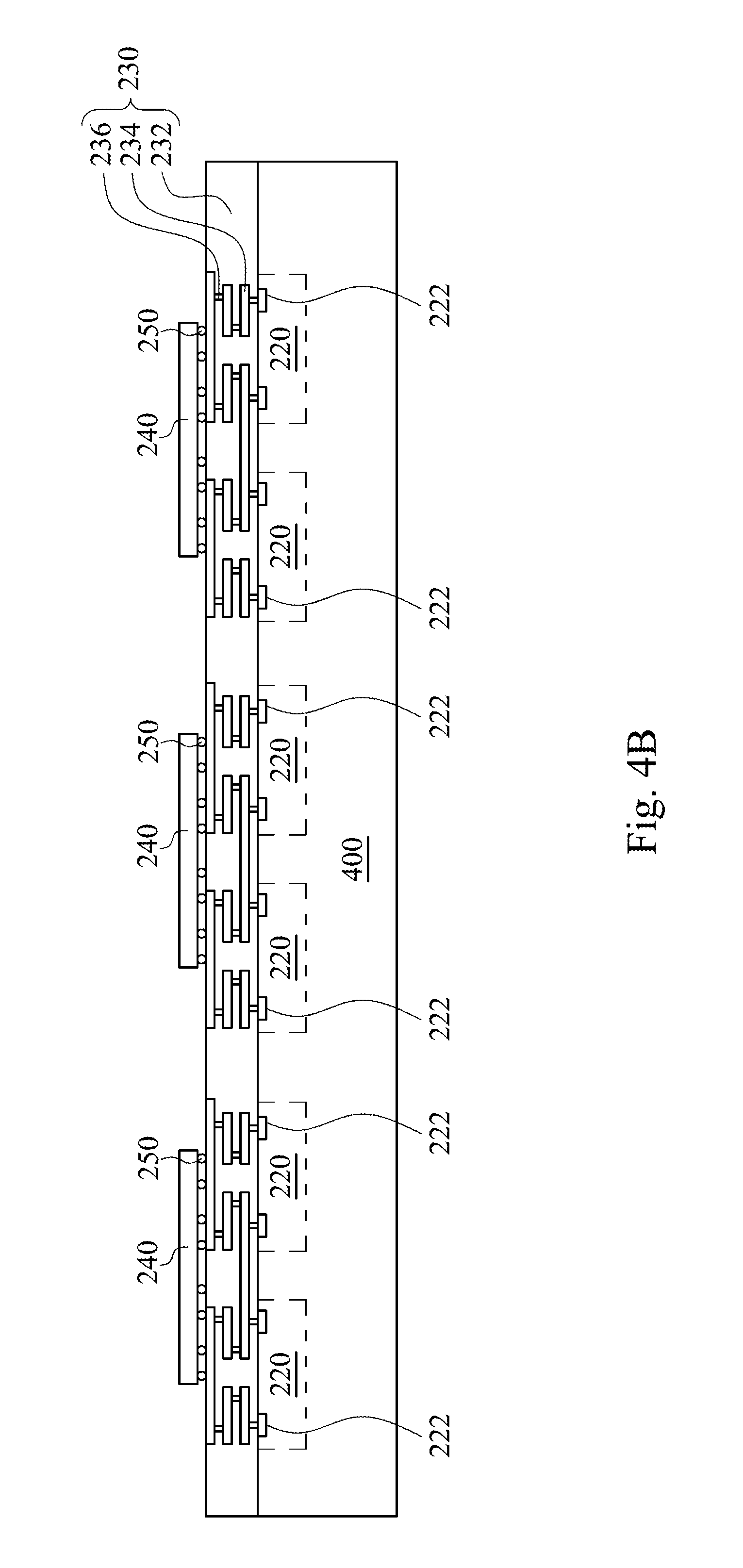
D00013
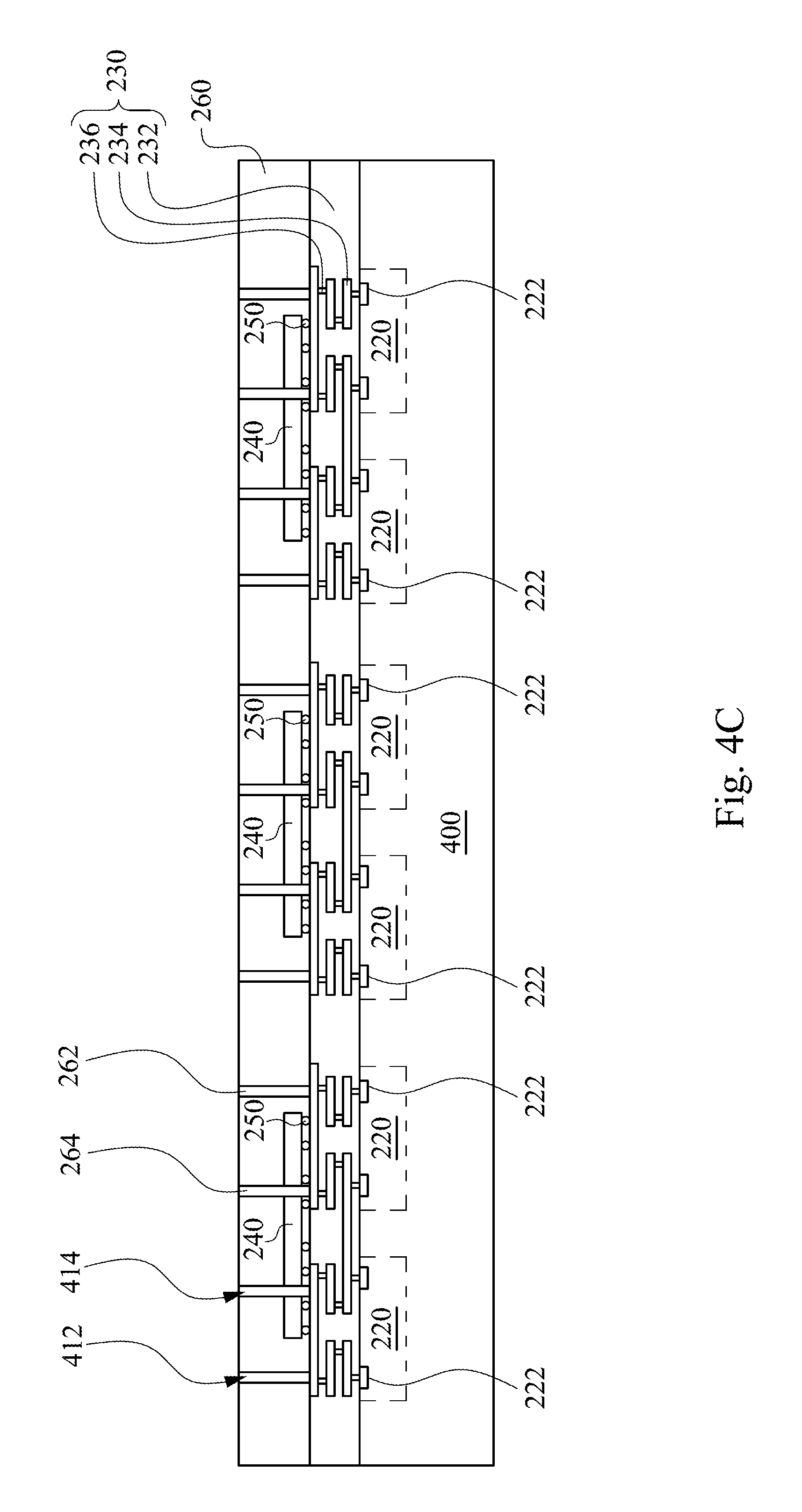
D00014
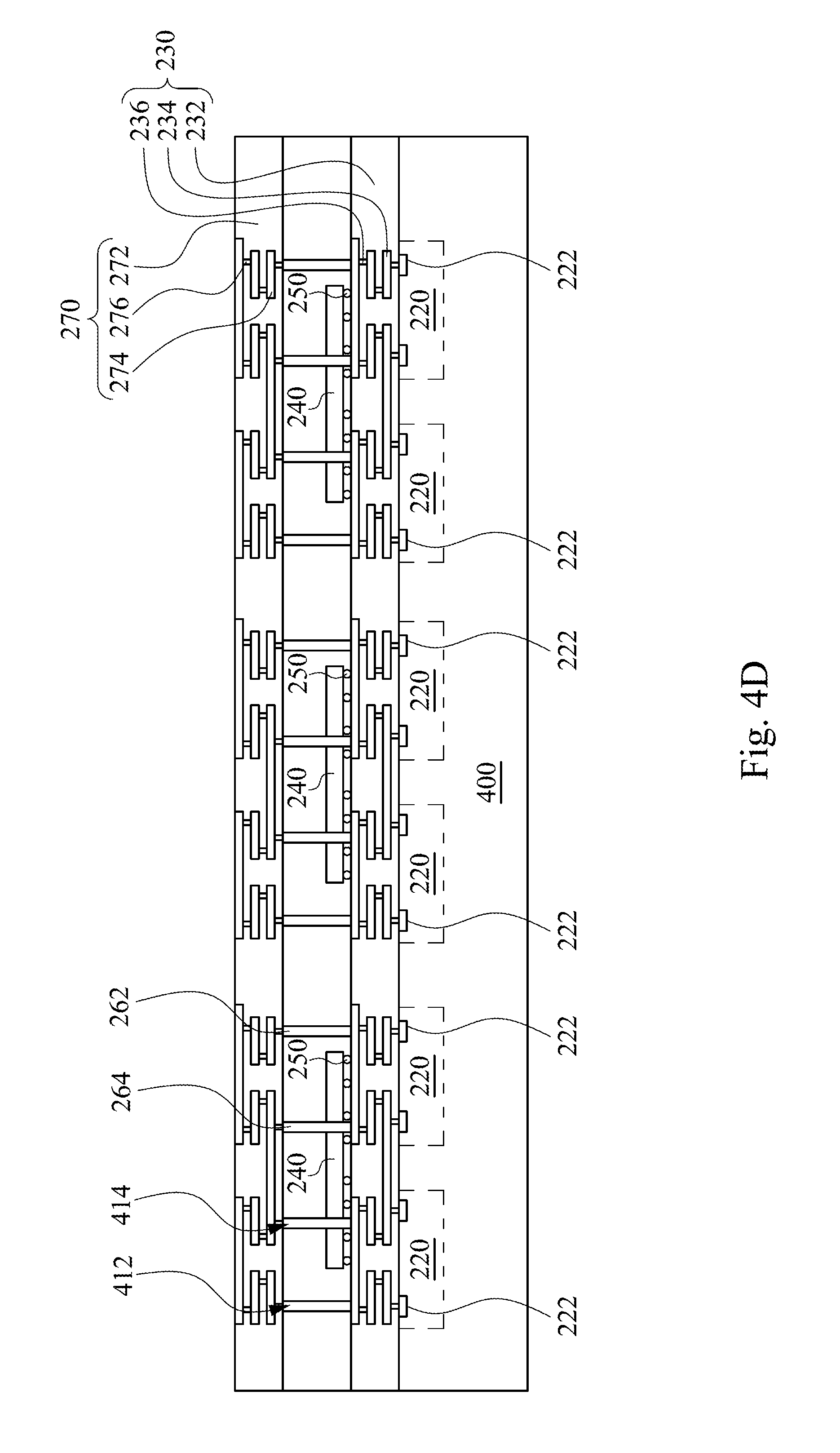
D00015
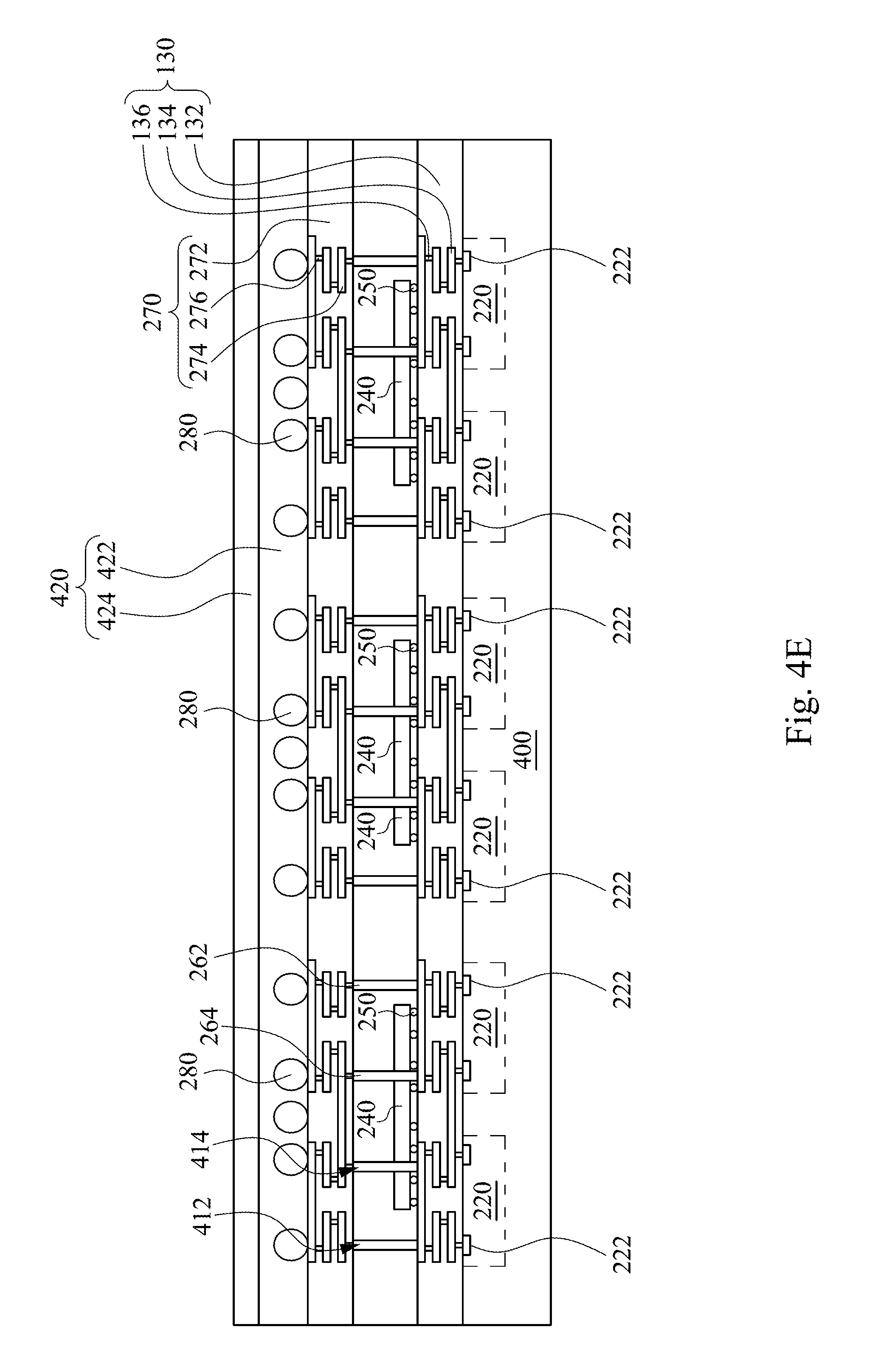
D00016
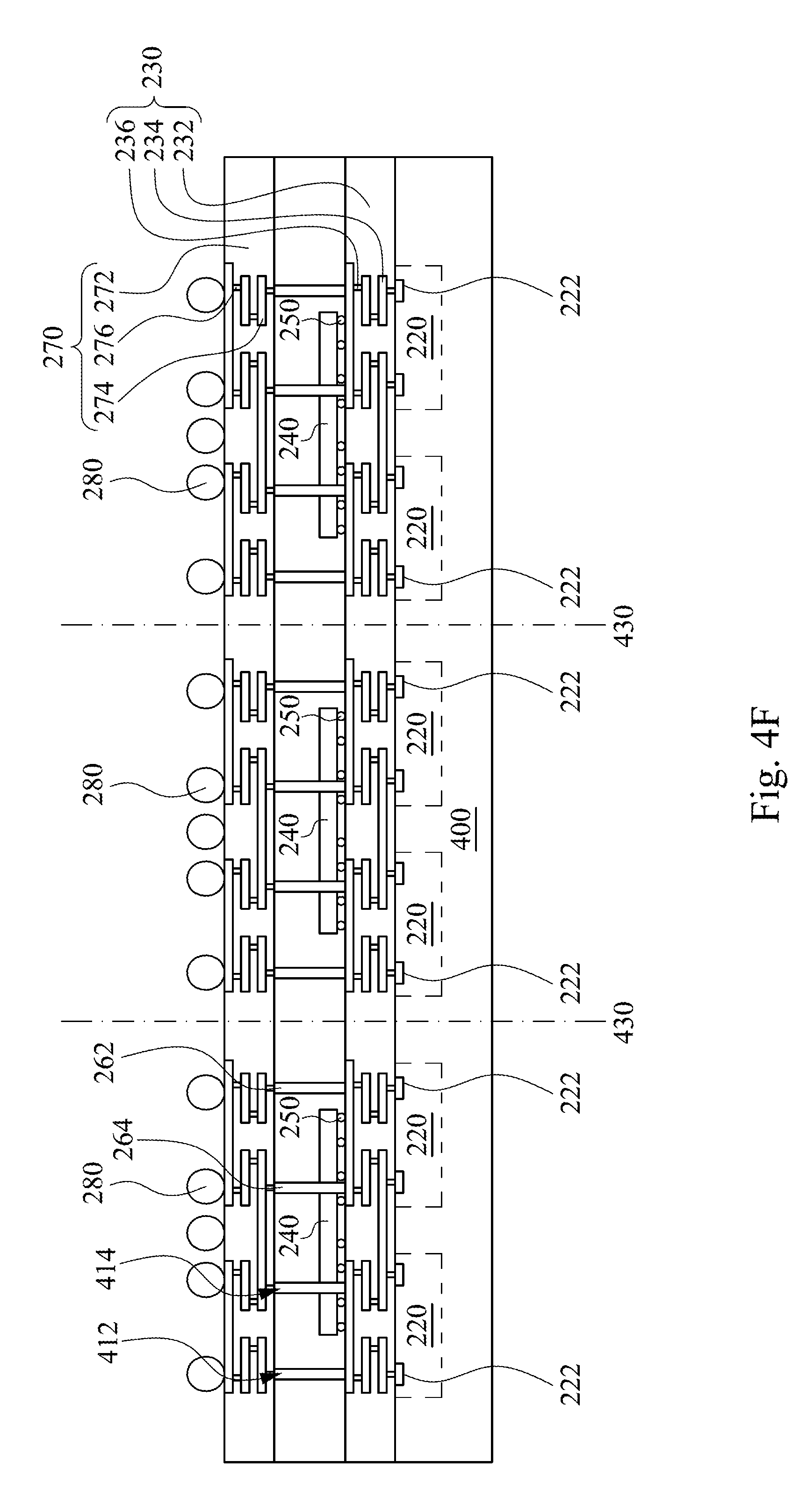
D00017
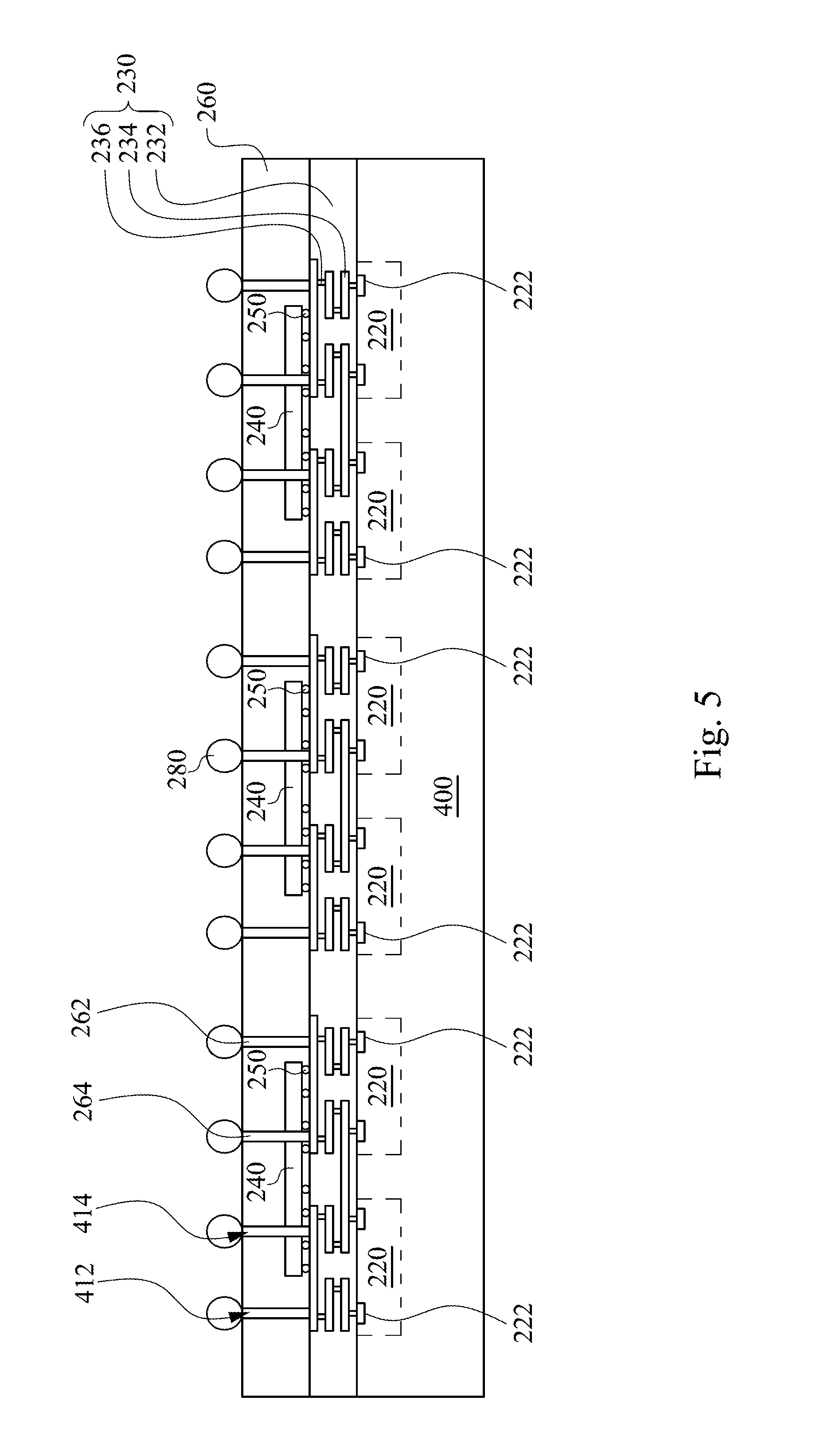
XML
uspto.report is an independent third-party trademark research tool that is not affiliated, endorsed, or sponsored by the United States Patent and Trademark Office (USPTO) or any other governmental organization. The information provided by uspto.report is based on publicly available data at the time of writing and is intended for informational purposes only.
While we strive to provide accurate and up-to-date information, we do not guarantee the accuracy, completeness, reliability, or suitability of the information displayed on this site. The use of this site is at your own risk. Any reliance you place on such information is therefore strictly at your own risk.
All official trademark data, including owner information, should be verified by visiting the official USPTO website at www.uspto.gov. This site is not intended to replace professional legal advice and should not be used as a substitute for consulting with a legal professional who is knowledgeable about trademark law.